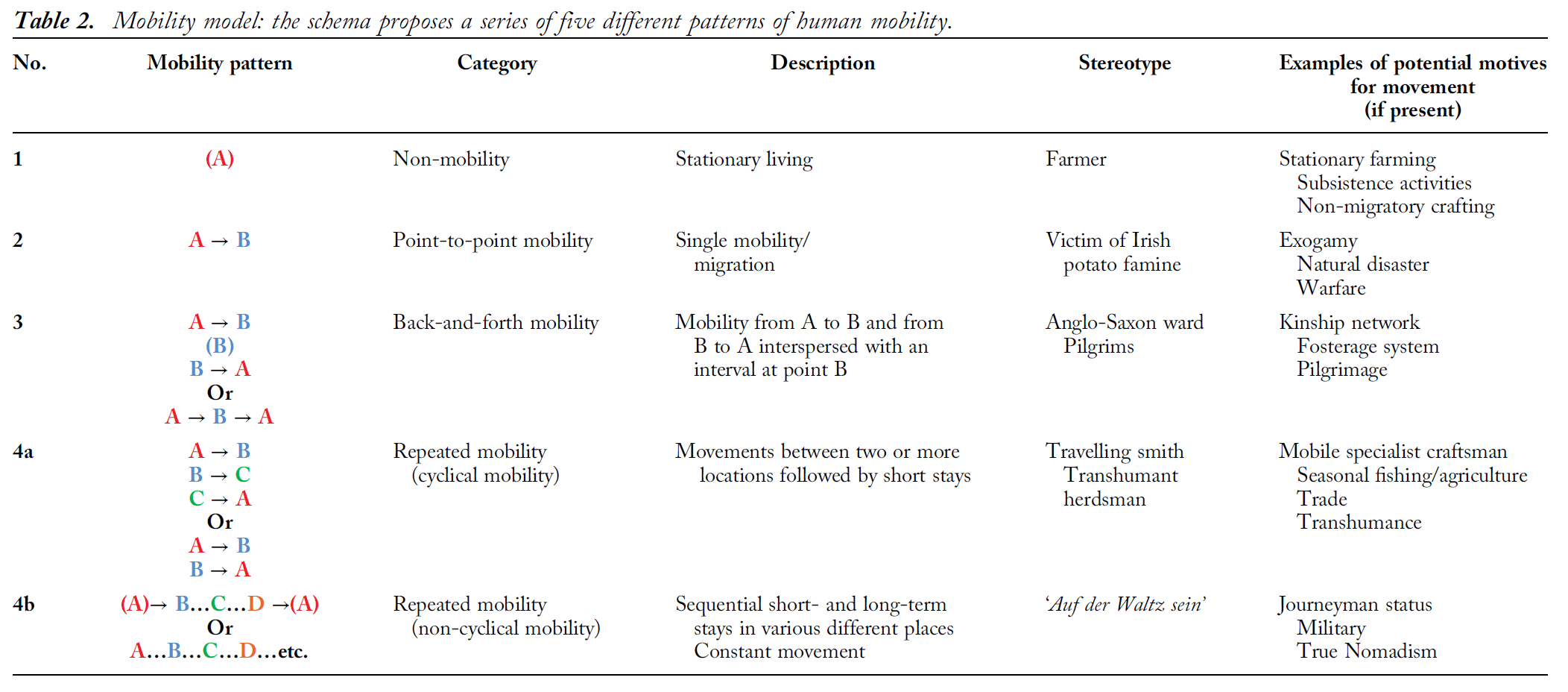New paper (behind paywall), Interpreting Past Human Mobility Patterns: A Model, by Reiter and Frei Eur J Archaeol (2019).
Interesting excerpts (modified for clarity; emphasis mine):
Present investigations of mobility can be divided into two main groups: 1) individual mobility, and 2) group mobility.
Research approach
(…) it is arguable that, ‘the reality of a mobile existence is far more complex than the ordering principles used to describe it’ (Wendrich & Barnard, 2008: 15). It seems that the most accurate means of modelling mobility is through a thorough examination of a variety of phenomena in combination with archaeological context. Notable examples of these defining criteria include:
- Mobility (length of time, season);
- Number of journeys;
- Segment of the population which moved (as defined by gender, age, health, occupation, or social position);
- General socio-political organization;
- Logistics and available modes of transport.
In an ideal world, these five categories should be investigated via multiple samples from multiple individuals from a site, region, and culture group who represent the full gamut of ages, sexes, and social levels. Unfortunately, the fragmentary nature of the archaeological record rarely includes material suitable for covering all parameters.
A mobility model
Thirty years ago, David Anthony criticized archaeologists for their approach to migration: ‘instead of developing the needed tools, archaeologists have avoided the subject’ (Anthony, 1990: 895).
Although there are (and always will be) holes in the record, we propose a mobility model composed of four over-arching mobility patterns which we have named as follows:
NOTE. Cases explored in the paper are within brackets.
- Non-migratory [no mobility: The Case of Singen (Germany)];
- Point-to-point migratory [The Case of the Skrydstrup Woman (Denmark)];
- Back-and-forth [The case of Haraldskaer Woman (Denmark)];
- Repeated mobility, subdivided into
- Cyclical mobility [The cases of Nieder-Mörlen (Germany) and Ötzi (Italy)]
- Non-cyclical mobility [The cases of the medieval Silk Road, Roman York, Viking Age Trelleborg, and La Tène Bohemia]
All told, the mobility patterns identified in the present model cleave to three overarching kinds of mobility: non-mobility, single mobility/migration, and multiple movements. The causes of non-mobility and different types of mobility can be manifold.
Non-mobility may include lack of sufficient funds or surplus, social obligations, health status, age, and social standing (serf, slave, landed gentry).
Single, unidirectional movements may have been caused by marriage alliances; family movements; social, political, or economic instability; violence (enslavement, kidnapping); or health issues.
By contrast, individuals who show evidence of multiple movement were likely to have been moving because mobility formed part of their employment, beliefs (ritual), or lifestyle. Although a warrior or soldier, herder, trader, or traveller within an extensive kinship network may present very different mobility patterns, they are all unified by the fact that their chosen occupation or social group(s) exhibit some form of mobility mandate.
The causes of back-and-forth mobility are difficult to define as different reasons could spur a single to-and-from journey to a specific place of cultural, religious, or personal importance.
Repeated mobility, be it cyclical or more irregular (non-cyclical), can also be closely related to social status. For example, a peddler, small-scale trader, or migrant worker’s identity and integration (or nonintegration) into the society (or societies) with which they have contact can be defined by their transitory lifestyles. (…) both the profession and its mobile nature removed metalworkers from ‘normal’ society; in many cases, they formed a separate social category (Neipert, 2006). This could also be the case with warriors. Although contact with migratory workers or specialists was necessary for temporary collaboration, prolonged contact might involve severe social change (Neaher, 1979; Bollig, 1987).
Related
- The importance of fine-scale studies for integrating palaeogenomics and archaeology
- Lazaridis’ evolutionary history of human populations in Europe
- David Reich on social inequality and Yamna expansion with few Y-DNA subclades
- David Reich on the influence of ancient DNA on Archaeology and Linguistics
- Kortlandt: West Indo-Europeans along the Danube, Germanic and Balto-Slavic share a Corded Ware substrate
- Massive Migrations? The Impact of Recent aDNA Studies on our View of Third Millennium Europe
- The uneasy relationship between Archaeology and Ancient Genomics
- The new “Indo-European Corded Ware Theory” of David Anthony
- Correlation does not mean causation: the damage of the ‘Yamnaya ancestral component’, and the ‘Future American’ hypothesis
- The renewed ‘Kurgan model’ of Kristian Kristiansen and the Danish school: “The Indo-European Corded Ware Theory”
- Germanic–Balto-Slavic and Satem (‘Indo-Slavonic’) dialect revisionism by amateur geneticists, or why R1a lineages *must* have spoken Proto-Indo-European

